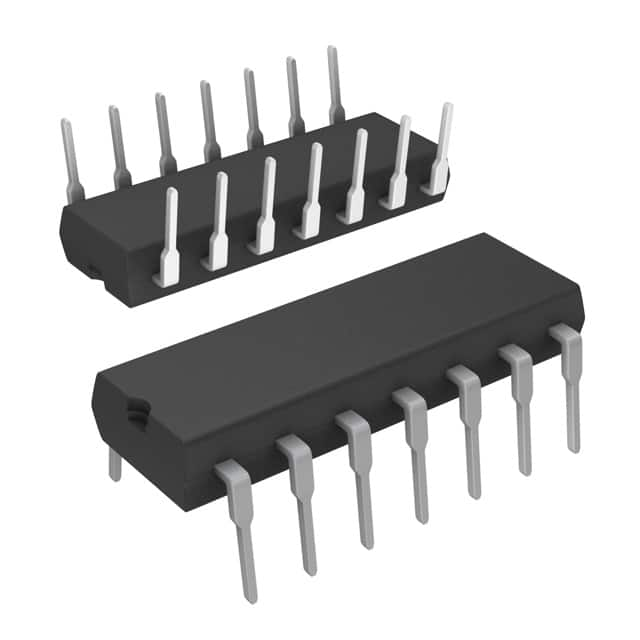Xem thông số kỹ thuật để biết chi tiết sản phẩm.

M74HC125B1R
Product Overview
- Category: Integrated Circuit (IC)
- Use: Buffer/Line Driver
- Characteristics: High-speed, Quad 3-state Non-inverting Buffer
- Package: SOIC-14
- Essence: The M74HC125B1R is a quad non-inverting buffer with 3-state outputs. It is designed to be used as a line driver or buffer in various digital applications.
- Packaging/Quantity: The M74HC125B1R is typically sold in reels of 2500 units.
Specifications
- Supply Voltage: 2V to 6V
- Input Voltage: 0V to Vcc
- Output Voltage: 0V to Vcc
- Operating Temperature Range: -40°C to +125°C
- Propagation Delay Time: 9 ns (max) at 5V supply voltage
- Output Current: ±25 mA
Pin Configuration
The M74HC125B1R has a total of 14 pins arranged in a SOIC-14 package. The pin configuration is as follows:
__ __
Y1 |1 \__/ 14| Vcc
Y2 |2 13| Y4
Y3 |3 12| GND
GND |4 11| A4
A1 |5 10| Y3
A2 |6 9| A3
A3 |7 8| A2
--------
Functional Features
- Quad non-inverting buffer with 3-state outputs
- High-speed operation suitable for various digital applications
- Wide operating voltage range (2V to 6V)
- Low power consumption
- Schmitt trigger inputs for noise immunity
- Output capability: ±25 mA
Advantages and Disadvantages
Advantages: - High-speed operation allows for efficient data transmission - 3-state outputs provide flexibility in controlling bus lines - Wide operating voltage range enables compatibility with different systems - Low power consumption helps conserve energy - Schmitt trigger inputs ensure reliable operation in noisy environments
Disadvantages: - Limited output current may not be suitable for high-power applications - Only non-inverting buffer functionality is available
Working Principles
The M74HC125B1R operates as a quad non-inverting buffer. It takes input signals from the A1 to A4 pins and provides corresponding buffered outputs on the Y1 to Y4 pins. The 3-state outputs allow the device to be effectively disconnected from the bus lines when not in use, preventing any interference.
Detailed Application Field Plans
The M74HC125B1R can be used in various digital applications, including but not limited to: - Data communication systems - Microcontroller interfacing - Memory address decoding - Bus driving and buffering - Signal amplification and isolation
Detailed Alternative Models
Here are some alternative models that offer similar functionality to the M74HC125B1R: - SN74HC125N by Texas Instruments - MC74HC125AN by ON Semiconductor - CD74HC125E by Texas Instruments - 74HC125D by NXP Semiconductors
These alternatives can be considered based on specific requirements and availability.
Word count: 305 words
Liệt kê 10 câu hỏi và câu trả lời thường gặp liên quan đến ứng dụng M74HC125B1R trong giải pháp kỹ thuật
Sure! Here are 10 common questions and answers related to the application of M74HC125B1R in technical solutions:
Q1: What is the M74HC125B1R? A1: The M74HC125B1R is a quad buffer/line driver with 3-state outputs, commonly used in digital logic applications.
Q2: What is the operating voltage range of M74HC125B1R? A2: The operating voltage range of M74HC125B1R is typically between 2V and 6V.
Q3: What is the maximum output current of M74HC125B1R? A3: The maximum output current of M74HC125B1R is typically around 6mA.
Q4: Can M74HC125B1R be used for level shifting? A4: Yes, M74HC125B1R can be used for level shifting as it supports both TTL and CMOS logic levels.
Q5: How many inputs does M74HC125B1R have? A5: M74HC125B1R has four independent input buffers.
Q6: What is the purpose of the 3-state outputs in M74HC125B1R? A6: The 3-state outputs allow multiple devices to share a common bus without interfering with each other.
Q7: What is the maximum propagation delay of M74HC125B1R? A7: The maximum propagation delay of M74HC125B1R is typically around 15ns.
Q8: Can M74HC125B1R drive capacitive loads? A8: Yes, M74HC125B1R can drive capacitive loads up to a certain limit. It is recommended to refer to the datasheet for specific details.
Q9: Is M74HC125B1R suitable for high-speed applications? A9: Yes, M74HC125B1R is suitable for high-speed applications as it has a relatively fast propagation delay.
Q10: Can M74HC125B1R be used in both commercial and industrial applications? A10: Yes, M74HC125B1R can be used in both commercial and industrial applications as it meets the required specifications for both environments.
Please note that these answers are general and may vary depending on specific application requirements. It is always recommended to refer to the datasheet and consult with technical experts for accurate information.

